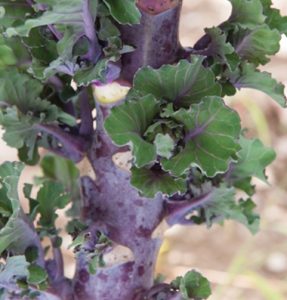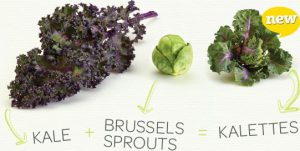It’s not often that a new vegetable comes along, so I’m really looking forward to trying the new Kalettes this year. Developed in Great Britain, where they are called Flower Sprouts, this new vegetable is a hybrid cross between Brussel sprouts and kale. The result is beautiful. They resemble miniature, ornamental kale rosettes with purple highlights on dark green, leafy buds growing in the leaf axils along the stem – just like Brussel sprouts. Kalettes are the result of conventional breeding; both parents belong to the Brassica oleracea species, which also includes cabbage, cauliflower and broccoli.
And they’re good for you, too. One cup of Kalettes contains 5 grams of fiber and 90 percent recommended daily allowances for vitamin C and 15 percent for iron.
The flavor of Kalettes is described as both sweet and nutty. They can be boiled, baked, steamed, roasted, microwaved or stir-fried. Recipes are available on the U.S. and British websites: https://www.kalettes.com/homepage/recipes/ and http://www.flower-sprout.com/cooking-and-recipes.php.
You may have seen Kalettes at local specialty markets as kale sprouts, but now you can also grow them at home. Johnny’s Selected Seeds is currently the exclusive vendor for seeds in the U.S. and provides the following growing information.

Kalettes look like a miniature ornamental kale but grow similar to Brussels sprouts.
Photo credit: Johnny’s Selected Seeds
“Kalettes will produce the best when planted in fertile soils with pH 6.5-7.5. The crop should be well-fertilized and irrigated in dry weather. Cool weather will provide the best growing conditions, especially when forming florets, but the plants will grow well in areas with mild summer weather prior to floret formation. While direct seeding is possible, it is recommended to transplant these crops. Sow seeds one-fourth-inch deep in containers four to six weeks before transplanting. When ready, plant in the garden with 18 inch spacing between plants, in rows 24 inches apart. For a fall harvest, transplant in June-July.”
Johnny’s offers three cultivars from seed. Autumn Star for early season (110 days to harvest), Mistletoe for mid-season (124 days to harvest) and Snowdrop for late season (138 days to harvest).
More information is available online at http://www.johnnyseeds.com/c-1066-kalettes.aspx.
